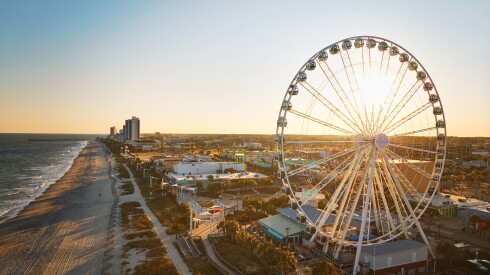There are plenty of ways to take in the Scottish countryside—whether on a road trip, an overnight train journey, or even by foot on a long-distance trek. But arguably the most underrated method is on a boat, sailing between the country’s rugged islands, spotting marine wildlife, and immersing yourself in miniature harbor-front villages. An intimate, adventurous alternative to cruising, St. Hilda Sea Adventures runs a fleet of small-boat sailings on vessels that sleep 6 to 11 passengers, and they operate a bit like a cross between an expedition cruise and a private chartered yacht.
Broadly speaking, St. Hilda’s itineraries focus on the 900 or so islands that dot the Scottish coastline; the vast majority of them can only be accessed via ferry or private vessel. They include the Inner Hebrides (which includes the islands of Skye, Mull, and Islay), the Outer Hebrides (home to the islands of Lewis and Harris), or the particularly rugged St. Kilda archipelago, which is about 100 miles off the Scottish mainland.
I was particularly drawn to St. Hilda because of the amazing wildlife-watching there; it felt like the British take on a Galápagos Islands cruise. Depending on the season, that might mean spotting whales, dolphins, seals, sea eagles, otters, and more seabirds than you can count. Extremely lucky passengers might even catch a glimpse of a basking shark, a gentle giant that eats plankton and can reach up to about 30 feet long. Here’s what it’s like to see all the unique charms of Scotland from a cozy and intimate bobbing boat.
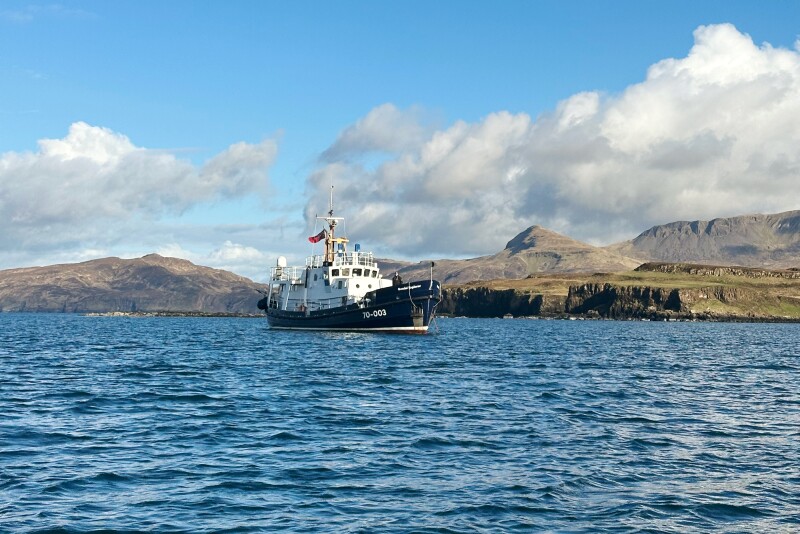
The Gemini Explorer is a retired lifeboat that’s been reborn as a small-boat cruising vessel.
Photo by Nick DeRenzo
The boat
From its homebase at a marina just outside of Oban, on Scotland’s west coast, St. Hilda Sea Adventures runs a four-vessel fleet that includes the 6-passenger St. Hilda, a two-masted sailboat built in 1973; the 11-passenger Seahorse II, a former Norwegian ferry designed to navigate through fjords; and the 8-passenger Speideren, a 1960s-era Norwegian rescue ship. The boat for my itinerary was the Gemini Explorer, a former lifeboat that was based on the North Devonshire coast and retired in 1989 after helping to save 44 lives.
At just 72 feet long, the eight-passenger Gemini Explorer offers tight but comfortable quarters. Below deck, there are five cabins, which sleep one or two people each; some have en suite bathrooms (you have to bring all your own toiletries) and others share a bathroom with the small crew. I stayed alone in a double en suite room at the bow, which included a lofted bed with storage underneath and a compact bathroom with not much room to spare. My six-foot frame was admittedly a bit tall for the shower, but even on the most sprawling of mega-ships, I tend to find cabin bathrooms a squeeze.
The bridge (aka the wheelhouse) and the galley (or kitchen) share the main deck with a common area that’s centered around a long, cushioned communal dining booth, where passengers gather to chat and trade stories, to consult the well-stocked library of bird-watching guides and coastal walking maps, or to engage in a tipple from the honesty bar, stocked with Scotches and Scottish gins. Outside, there’s an upper deck—reached via a ladder—with teak benches that are a great (if windy) place to spot passing seabirds or gaze out over the horizon in search of whales and dolphins.
The three-person crew on our vessel included a chef, a deckhand, and a skipper named Captain Dougie, who functions as a cruise director, a tour guide, and a wildlife spotter, in addition to his main duties steering the boat. (He’s also the conga player in a band called Salsa Celtica that pairs Afro-Caribbean beats with traditional Irish and Scottish music.)
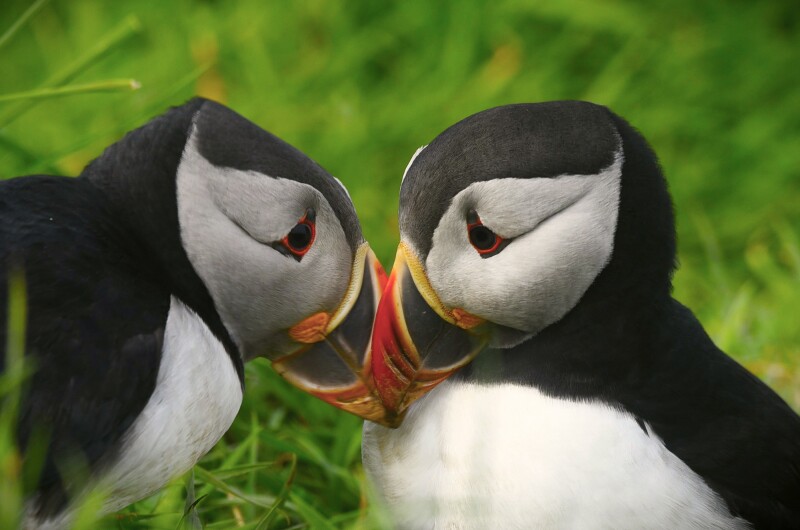
Puffins are one of the most charismatic species that guests can expect to see during a cruise along the Scottish coast.
Courtesy of St. Hilda Sea Adventures/Gary Barber
The route
St. Hilda sails private charters as well as a host of themed itineraries based around activities like creative writing, photography, whisky-tasting, or golf. In April, I joined a six-night cruise called Isle of Mull and Small Isles Explorer, which takes in the Isle of Mull (340 square miles of castles, distilleries, and picturesque seaside villages) and a nearby cluster of tiny islets. Boats depart from Dunstaffnage Marina, three miles north of Oban, a regional tourism hub that’s about three hours from Glasgow by train. I spent a predeparture night in town at the 1880s-era Perle Oban Hotel, dining on langoustines from the dockside Oban Seafood Hut and climbing up to the Colosseum-like McCaig’s Tower.
Much like an expedition cruise, the route is loosely planned but highly dependent on the weather and the conditions at sea. On the first day, after welcome tea and scones, we sailed past the 13th-century Duart Castle, the seat of Clan MacLean, and anchored in Loch Aline, where we chatted about the rough plans of our outing. Each day would involve a bit of whale- and seabird-watching while in transit, and if conditions allowed, we’d pull into a harbor and use the onboard Zodiac as a tender boat to take us ashore for hiking, bird-watching, or some cultural tour.
When we reached the Isle of Canna on day two, for instance, we met with Tom, a ranger from the National Trust for Scotland, which manages this island. “We’ve just gone up to the massive population of 22,” he told us on a walk around the island. “We had a baby boom of 2.” Tom led us through hillsides bursting with fragrant wild garlic and gorse, a shrub with golden flowers that smell uncannily like coconut; past paddocks of newborn lambs and a pint-size post office; and up to archaeological ruins that include a monastic settlement that most likely dated from the 7th to 9th centuries, with an intricately carved Celtic cross.
Even more impressive was Café Canna—perhaps the most sophisticated restaurant you’ll ever find in a community with a double-digit population. Seaweed, fish, and shellfish harvested from the shores and eggs, beef, and vegetables from the island’s farms feature in menu items like wild garlic laksa, kelp spanakopita, peat-smoked mackerel gratin, and gorse crème brûlée. Back on the Gemini Explorer, we rounded the coast of Canna and found towering basalt cliffs, teeming with thousands of seabirds, including puffins, razorbills, and guillemots.
On the island of Eigg, we strolled along beaches overrun with fluffy rabbits, in the shadow of a towering volcanic formation called An Sgùrr. We then piled into a van with a bushily bearded taxi driver named Charlie who started his tour of the community by offering us each a hearty swig of whisky; a highlight was the Cleadale Crofting Museum, which feels like a trapped-in-time farmer’s house that’s been left with the door unlocked for wanderers to come and discover.
The island itself is a unique arrangement, owned by members of the roughly 110-member-strong community and the Scottish Wildlife Trust, and the entire place runs on wind, solar, and hydroelectric energy. (Be sure to try a beer from the Isle of Eigg Brewery, Scotland’s first cooperative brewery, which makes beer by using solar panels and batteries.)
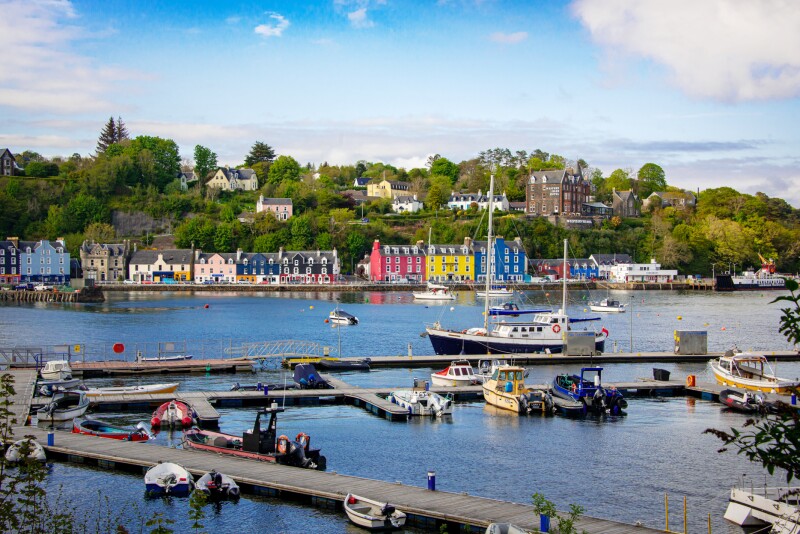
The colorful waterfront village of Tobermory is home to a historic distillery and plenty of charming shops.
Courtesy of St. Hilda Sea Adventures / Tony Barber Photography
On another day, when conditions didn’t allow for landing, we tooled around a loch on a Zodiac as sea eagles swooped overhead. We scooted past rocky outcroppings piled with harbor seals, including aww-inspiring pups that looked like Japanese plush toys. Some lay in the yoga-like “banana pose,” a common seal position to regulate body temperature; others bobbed in the water and followed our boat like inquisitive puppies.
Elsewhere, we passed hulking rusted shipwrecks poking out of the surface and cliffs dotted with shaggy goats that were originally brought to these islands to collect their hair for wigmaking—really. Back on the Isle of Mull, we stopped at the town of Tobermory, which felt positively bustling with a population of about 1,000. Its arcing waterfront of colorful buildings is so cheerful that it was chosen as the setting of the BBC kids story Balamory. Once ashore, some of our group hiked through songbird-filled forests to a waterfall, and others toured the Tobermory Distillery, which dates back to 1798.
Depending on the day or the weather conditions, passengers also have the opportunity to take out a kayak on their own and paddle around the lochs or harbors where the boat has anchored—or, if they’re feeling particularly adventurous (as one of my fellow passengers was on a couple of occasions), jump right into the bracingly chilly waters, either from the deck or from beaches on islands where we’ve stopped.
The experience aboard
As a true devotee of chitchatting, I was immediately charmed by how intimate and friendly these cruises are—almost by necessity. If you’re an introvert or spend all your time down in your cabin, you’ll be missing out on half the fun of a communal experience like this.
Among the six passengers on my cruise were a mother-and-daughter duo from the north of England who were aboard to spread their patriarch’s ashes (the mom turned 86 during the sailing and was spryer than most of my friends); a sports psychologist who travels the world photographing her stuffed elephant in exotic locations; and a Celtic accordionist from the German coast who had recently walked the Camino de Santiago after the death of her husband.
Because cabins are small and you can’t fall back on the distraction of Wi-Fi, everyone is drawn to the common areas. Over tea or whisky, we shared travel tales, learned about each other’s hometowns and families, and debated about birds we had spotted earlier in the day—we still haven’t decided if it was a golden eagle or a white-tailed eagle.
One day, I came to the table to discover my new German friend mending the ripped strap of my shoulder bag with the sewing kit from her carry-on, and a few months after our trip, we still have a WhatsApp chat going strong in which we occasionally share lists of the backyard birds we’ve seen that week.
The food and drink
Operating out of a galley the size of one you might find in a New York City studio apartment, the boat’s chef works magic, though the vibe is obviously more like an intimate dinner party than a sure-you-can-order-the-lobster-and-filet experience you’d find on a larger cruise ship. When not cooking for St. Hilda, our chef works at a much, much larger-scale catering company that serves professional soccer teams in Glasgow.
Mornings began with bowls of warming porridge and a rotating assortment of eggs, sausages, pancakes, and toast; we ended most evenings with a “what do you guys feel like eating tomorrow morning?” conversation. (I personally became a Marmite man on this trip.) After outdoor activities, we warmed up with afternoon tea and freshly baked scones or shortbread.
Lunches and dinners were a time for our chef to show off a bit: turkey and leek pie with chips, mushroom and spinach risotto, chicken curry with bhaji and chutney. And because our cruise fell over Easter weekend, a full lamb roast with Yorkshire pudding, roasted vegetables, mashed and roasted potatoes, and floods of gravy and mint sauce. Note that St. Hilda is a member of the Marine Conservation Society, a sustainability group that prevents the company from putting overfished species (like lobster) on the menu.
But the dish I’ll perhaps remember the most is cranachan, a simple, traditional dessert made of oats, raspberries, whisky, and whipped cream.
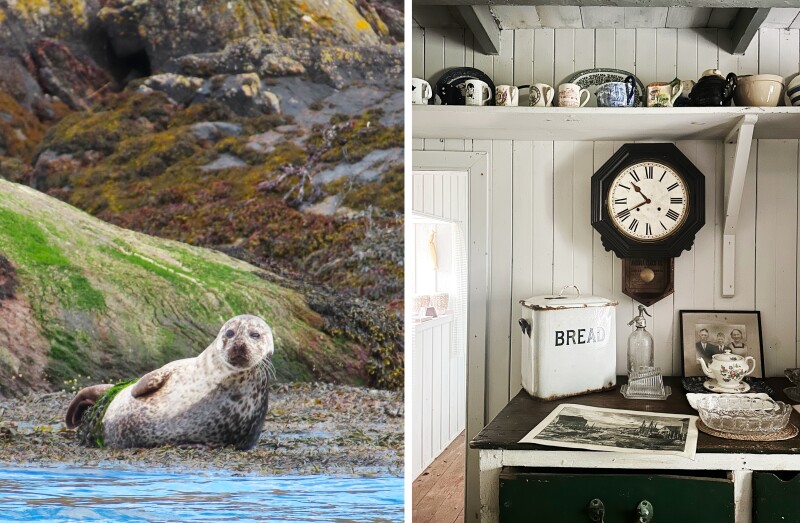
Harbor seals are a regular presence on cruises around the Scottish islands; the crofting museum on Eigg feels like stumbling into an unlocked farmhouse.
Photos by Nick DeRenzo
The verdict
If you’re a megaship skeptic, you’ll be smitten with the scale and personalization of a tiny-boat cruise. St. Hilda is a family-run Scottish business, and you can feel that in every step of the experience—from the fresh-baked scones awaiting you upon arrival to the partnerships with local guides who offer a true islanders’ perspective of the scenery and history.
Be warned that this intimacy isn’t for every kind of traveler: If you’re not very social and are hoping to keep to yourself with a book, that’s definitely not the vibe here. You’ll be sharing every meal and activity with your fellow passengers, so you need to be OK with a lot of small talk. Because of the size of the ship, passengers will also need to be relatively fit to be able to, say, shimmy backwards down the ladder to their cabin or hop onto the Zodiac (as it bobs in the water) to get to shore.
Cabins are admittedly compact and no frills, but this is not the kind of cruise where you’re meant to be relaxing in a bathtub or watching TV from bed; this is an active expedition where you’ll be out and about for most of the day. As a type-A traveler who very much loves planning, I was particularly taken with how (literally) go-with-the-flow the itineraries are by necessity. You have to stay in the present, because you don’t know how winds or waves are going to impact where you’ll be stopping tomorrow. In a weird way, that lack of control proved surprisingly calming, offering me a truly relaxing experience that I sometimes have trouble finding on land when I’m always planning the next part of my trip. Here, I just had to let those concerns and worries sail away.







